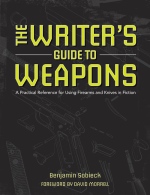When researching knives for a story, you may come across wavy patterns on the blade that look like this:
Without getting too technical, those waves are created by layering the steel used to make the blade. The result is called “damascus” steel. A wave pattern is just one of the shapes found in damascus steel. The smith can create any number of wacky designs, from hearts, stars and horseshoes to clovers and blue moons. Er, wait, that’s the jingle for Lucky Charms. But the point is still the same.
Some say damascus steel is stronger or longer lasting than “regular” steel. I’d say there are too many variables to make that judgement call. It’s strictly a design element that looks cool and adds a nice touch to a knife. Here’s an example from one of my own knives.
In this case, the damascus steel has a “raindrop” pattern instead of wavy lines like in the example above. It’s still damascus either way.
When writing, the only time I imagine you’d reference damascus is to look in-the-know about knives, which is fine by me. Because damascus is pricey and most often used for aesthetics, I wouldn’t depict it on knives designed for hard use.
Get the Book
 The Writer’s Guide to Weapons: A Practical Reference for Using Firearms and Knives in Fiction (Writer’s Digest Books) comes with everything but the ammo. Pick up a print or digital copy from these fine retailers:
The Writer’s Guide to Weapons: A Practical Reference for Using Firearms and Knives in Fiction (Writer’s Digest Books) comes with everything but the ammo. Pick up a print or digital copy from these fine retailers:


The processes and reasons for damascus steel have always fascinated me, but I’ve never been able to find any answers for how it compares to steels made with more modern methods.
LikeLiked by 1 person
There are so many ways to use damascus that I’m not sure you could make a blanket statement. The heat treating matters quite a bit regardless of the steel, as well as the way the steel is layers out. The one in my pic has a soft core (it’s like a sandwich with the damascus on the outside), but other designs use a separate softer steel for the spine. Because they’re usually for display instead of hard use, makers probably shy away from the materials and processes that would make the blade tough as hell, but they don’t necessarily have to. For writing fiction, I don’t think there’s a difference.
LikeLike
I didn’t mean to sound like I wanted a blanket statement. XD That would be boring. I meant I’d like to see a study (or talk to someone very experienced with Damascus steel) to understand it’s characteristics in contrast with the characteristics of say… tool steels, etc. I’ve heard that the primary reason we don’t use it much anymore is because it’s so much more labor-intensive to create.
On the subject of layering, do you happen to know how the layers in the Damascus steel differ under tempering? From what I understand, the layers have different carbon content and are layer-welded to create sort of an average carbon content. That seems like it would give you a knife (or sword) with a hardness that varies from layer to layer…
LikeLike
You’re right on that. It’s all about keeping cost down, on top of the fact most of the cheap tool steel out there is imported. They try to get away with etching damascus-y patterns into the steel instead of going through with the real deal. For that reason, I wouldn’t buy anything under $100 claiming to have a damascus blade unless I can see it up close.
If you send me your e-mail address, I’ll send you something from BLADE that might help with understanding that bit about the layers. (might be a couple days for me to get back to the office yet)
LikeLike
There aren’t a lot of people who can create real Damascus steel anymore, as far as I know. 😉 I can’t imagine the etching would work very well. *eyeroll*
Cool! I sent it through your contact form; hope that’s okay?
LikeLiked by 1 person
That’s perfect. I’ll send it when I’m back at the office. Probably the next day or so.
LikeLiked by 1 person